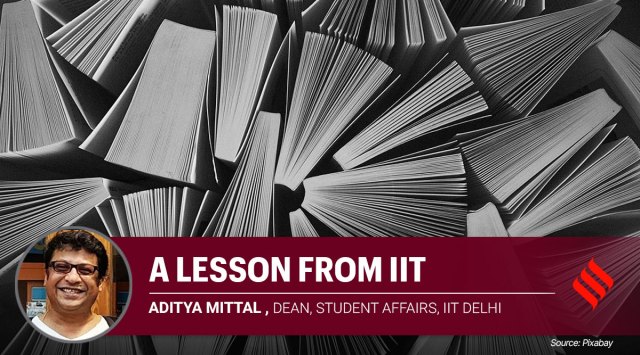Are NCERT textbooks enough for JEE Advanced preparation? IIT Delhi professor explains
"Over the years, thanks to multiple policies of the government of India, the outreach of the NCERT material has unquestionably become the highest in our country," writes Mittal.
 Are NCERT books important for JEE Advanced 2023 preparations? IIT professor explains. (Graphics by Abhishek Mitra)
Are NCERT books important for JEE Advanced 2023 preparations? IIT professor explains. (Graphics by Abhishek Mitra) (‘A Lesson from IIT’ is a weekly column by an IIT faculty member on learning, science and technology on campus and beyond. The column will appear every Friday.)
— Aditya Mittal
Every year, students securing coveted admissions to premier engineering and technology institutions in India often remark about their primary focus on NCERT science books during preparations for their respective entrance examinations.
These “success stories” are from different parts of India, but they all have one thing in common — an emphasis on NCERT science books (and accompanying material).
In fact, even those compelled (either by societal or parental or personal pressures) to go through the grind of the coaching mills do not hesitate to emphasise that their “last mile” preparations are predominantly comprised of thorough understanding of NCERT study material via self-study (and/or with guidance from their school teachers).
Thus, it is obvious that NCERT textbooks are important for not only CBSE board examinations but also entrance examinations. One may ask why NCERT textbooks for entrance examinations?
To understand the primacy of NCERT books, it is first important to briefly consider the role of entrance examinations for admission into our premium engineering and technology institutions. In addition to the primary academic requirements served by entrance examinations, there are three major non-academic operational parameters for them: Equal opportunity to all, selection-of-few from many based on “objective” non-prejudicial evaluations, and transparent accountability of the selection process through these evaluations.
All the above three require the availability of a common and consistent source of preparation material.
NCERT books are just that — a common resource. Over the years, thanks to multiple policies of the government of India, the outreach of the NCERT material has unquestionably become the highest in our country. NCERT books and accompanying material is accessible to every nook and corner of the country. The print material is now also accompanied by online access. These books are also not limited to those who can financially afford them.
The Earth was considered the centre of the universe for centuries due to the beliefs of Aristotle and Ptolemy, who in spite of their greatness were wrong. The concept of the Sun being the centre, rather than Earth, came from Copernicus. It was considered blasphemous and unacceptable at the time.
Later, only after the contributions from Newton, Galileo and Kepler did the concept of the Sun being the centre of a solar system (which itself is miniscule a part of the universe) gain wide acceptability. Let us imagine an aspirant writing an examination with access to only resources from the times of Copernicus. These students would still inaccurately claim the Earth as a central astronomical body. This example is an oversimplified explanation for the requirement of having a consistently updated, uniform and readily available resource such as NCERT books.
Before 2000, NCERT books would have normal concepts, solved-examples and highlighted “boxed” material (generally in grey colour) for advanced critical thinking. These provided choices to students – whether they wanted to understand just the basics, or go into critical and analytical depth beyond the basics through the “boxed” content.
While CBSE examinations had much fewer references to the “boxed” content, entrance examinations would push the limits of material covered in both the general material as well as the “boxed” contents. Questioning the assumptions behind derivations, impacts of changing those assumptions, alternative routes to arriving at similar solutions, additional applications of certain theoretical concepts – these were some of the hallmarks of the “boxed” material in NCERT mathematics and science textbooks.
Current versions of the NCERT materials have similar contents in forms of “points to ponder”, “summary”, “solved examples” along with “exemplars” which are additional problem-solving material.
Thus, over the years, NCERT mathematics and science textbooks have emerged as a “centralised” resource, with a built-in flexibility for students to choose the level of depth they would like to go into for any particular concept. Material covered in these books can thus form the bedrock of framing questions at varying levels of difficulty. And more often than not, this helps in the selection-of-a-few from many or elimination-of-many to select a few.
(The writer is Dean, Student Affairs and former Chairman of JEE (Advanced) at IIT Delhi. Views expressed above are personal)































